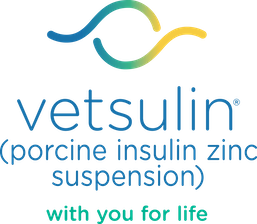

Transitioning to Vetsulin®
Learn More About Dosing & Administration
Transitioning to Vetsulin® for Dogs
General Guidelines
When transitioning a dog from another insulin product to Vetsulin®, many factors need to be considered, such as state of current regulation, duration of therapy and the presence of concurrent illness. These are some general recommendations for care:
- If regulation is considered adequate, it is suggested to start Vetsulin (porcine insulin zinc suspension) at 50%–75% of the dosage used with the previous insulin.
- If ideal regulation has not been achieved, it is important to confirm proper owner insulin administration as well as insulin handling. If no issues are discovered, the presence of an insulin resistance source (i.e. urinary tract infection) or Somogyi overswing should be investigated prior to transitioning as well.
- For an inadequately regulated dog, weigh the dog and start at labelled starting dose.
Rules for Conversion
In all cases, allow the animal to adapt to the new dosage for 5 to 7 days before adjusting the dose. It is recommended to assess the pet’s response to Vetsulin by evaluating clinical signs and performing blood glucose monitoring.
If necessary, increases in the dose should be performed in increments of 10%. If hypoglycemia is documented, the dose should be decreased. Following adjustment, wait to reevaluate until the new dose has been given for at least 5 to 7 days, unless evidence of hypoglycemia appears.
Twice-daily injections at 12-hour intervals may be indicated if the dog’s clinical signs persist and the blood glucose curve indicates a duration of activity of less than 14 to 18 hours.
From Once to Twice-daily Therapy
When switching dosage from once-daily to twice-daily, the Vetsulin dose needs to be decreased by 25%. For example, if a dog receives 20 IU of Vetsulin once daily, the new dose would be 15 IU twice daily.
Monitoring After Transition
After the dog is transitioned to Vetsulin, it is important to monitor the dog closely for signs of dysregulation as well as hypoglycemia.
It is not uncommon to experience a change in regulation associated with the transition between insulin products, due to differences in potency. In addition, the new product, syringe, concentration of the product or schedule of treatment may confuse the owner. Therefore, good communication at the time of transition and follow up visits are recommended.
To learn more, read the Transitioning Canine Patients with Diabetes Mellitus to Vetsulin® conversion chart.
Help Your Practice Manage Diabetes Mellitus
View and download resources and tools that will assist your hospital, inform your team, and help with clients.

Blood Glucose Curve Generator
Create a blood glucose curve to monitor and evaluate diabetes treatments.

Client Discharge Form
Create a customized, printable form for clients about their new diagnosis.

Diabetes Resources
Access online tools and more to support staff and pet parents.
No items to show.
Learn More About Dosing & Administration
Important Safety Information:
Vetsulin® should not be used in dogs known to have a systemic allergy to pork or pork products. Vetsulin is contraindicated during periods of hypoglycemia. Keep out of reach of children. As with all insulin products, careful patient monitoring for hypoglycemia and hyperglycemia is essential to attain and maintain adequate glycemic control and prevent associated complications. Overdosage can result in profound hypoglycemia and death. The safety and effectiveness of Vetsulin in puppies, breeding, pregnant, and lactating dogs has not been evaluated. See package insert for full information regarding contraindications, warnings, and precautions.
References:
1. Martin GJ, Rand JS. Pharmacology of a 40 IU/ml porcine lente insulin preparation in diabetic cats: findings during the first week and after 5 or 9 weeks of therapy. J Feline Med Surg. 2001;3(1):23–30. 2. Vetsulin® (porcine insulin zinc suspension) [Freedom of Information Summary]. Millsboro, DE: Intervet Inc.; 2008. 3. Data on file, Merck Animal Health. 4. Graham PA, Nash AS, McKellar QA. Pharmacokinetics of porcine insulin zinc suspension in diabetic dogs. J Small Anim Pract. 1997;38(10):434–438. 5. Martin GJ, Rand JS. Pharmacokinetic and Pharmacodynamic Study of Caninsulin in Cats with Diabetes Mellitus. 2000: Internal Study Report. 6. Feldman EC, Nelson RW. Canine and Feline Endocrinology and Reproduction. 3rd ed. St. Louis, MO: Saunders; 2004:539–579. 7. Tennant B, ed. BSAVA Small Animal Formulary. 4th ed. Gloucestershire, UK: British Small Animal Veterinary Association; 2002. 8. Feldman EC, Nelson RW. Canine and Feline Endocrinology and Reproduction. 3rd ed. St. Louis, MO: Saunders; 2004:486–538. 9. Reusch C. Feline diabetes mellitus. In: Ettinger SJ, Feldman EC, eds. Textbook of Veterinary Internal Medicine. 7th ed. St. Louis, MO: Saunders; 2010:1796–1816. 10. Nelson RW. Canine diabetes mellitus. In: Ettinger SJ, Feldman EC, eds. Textbook of Veterinary Internal Medicine. 7th ed. St. Louis, MO: Saunders; 2010:1782–1796. 11. Burgaud S, Riant S, Piau N. Comparative laboratory evaluation of dose delivery using a veterinary insulin pen. In: Proceedings of the WSAVA/FECAVA/BSAVA congress; 12–15 April 2012; Birmingham, UK. Abstract 121. 12. Burgaud S, Guillot R, Harnois-Milon G. Clinical evaluation of a veterinary insulin pen in diabetic dogs. In: Proceedings of the WSAVA/ FECAVA/BSAVA congress; 12–15 April 2012; Birmingham, UK. Abstract 122. 13. Burgaud S, Guillot R, Harnois-Milon G. Clinical evaluation of a veterinary insulin pen in diabetic cats. In: Proceedings of the WSAVA/FECAVA/BSAVA congress; 12–15 April 2012; Birmingham, UK. Abstract 45. 14. Davison LJ, Walding B, Herrtage ME, Catchpole B. Anti-insulin antibodies in diabetic dogs before and after treatment with different insulin preparations. J Vet Intern Med. 2008;22:1317-1325. 15. Banfield State of Pet Health 2016 Report. p 12-13.
